Are you pregnant and have an excessive curve in your lumbar spine?
Do you also suffer from low back pain?
You may have lordosis.
In this post I will teach you:
- What lordosis is and how pregnancy affects is,
- What specifically contributes to the development of it, and
- How to treat it safely.
Are you ready?
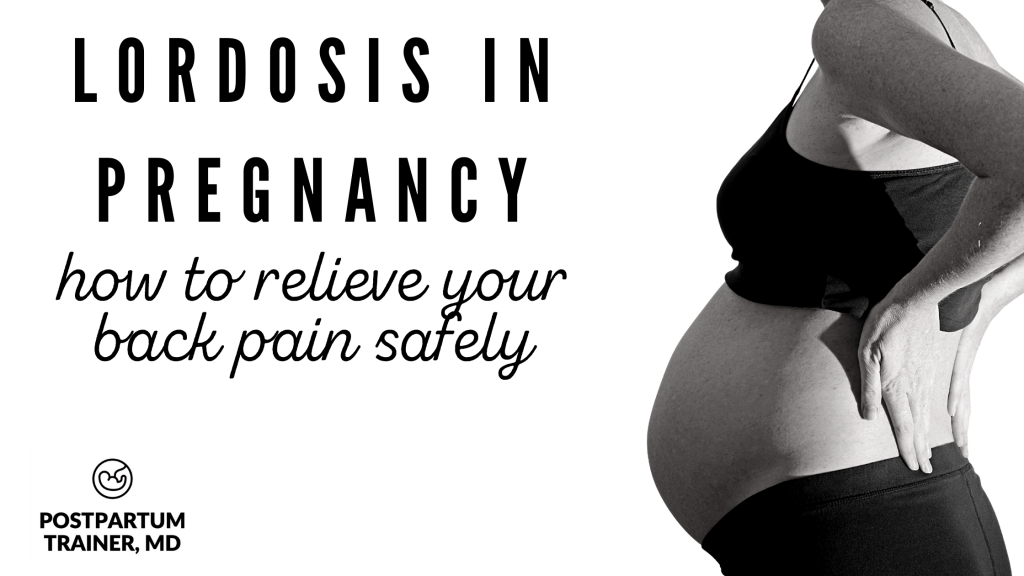
What is lordosis?
Lordosis is a condition in which there is an excessive inward curve in your lower back.
It is often caused by muscular imbalances between the muscles that attach to your pelvic bone anteriorly and posteriorly.
While it is natural to have a slight arch in this area- an excessive arch is not normal.
There are 3 main areas of your spine, each with a natural curve:
- The cervical spine is the uppermost portion and has a slight inward curve.
- Next is the thoracic spine which has a natural kyphotic or rounded appearance.
- Lastly, is the lumbar region which has a natural lordotic curve.
Any changes in these natural spinal curvatures can lead to lower back pain, muscle strain, muscle dysfunction, and injuries.
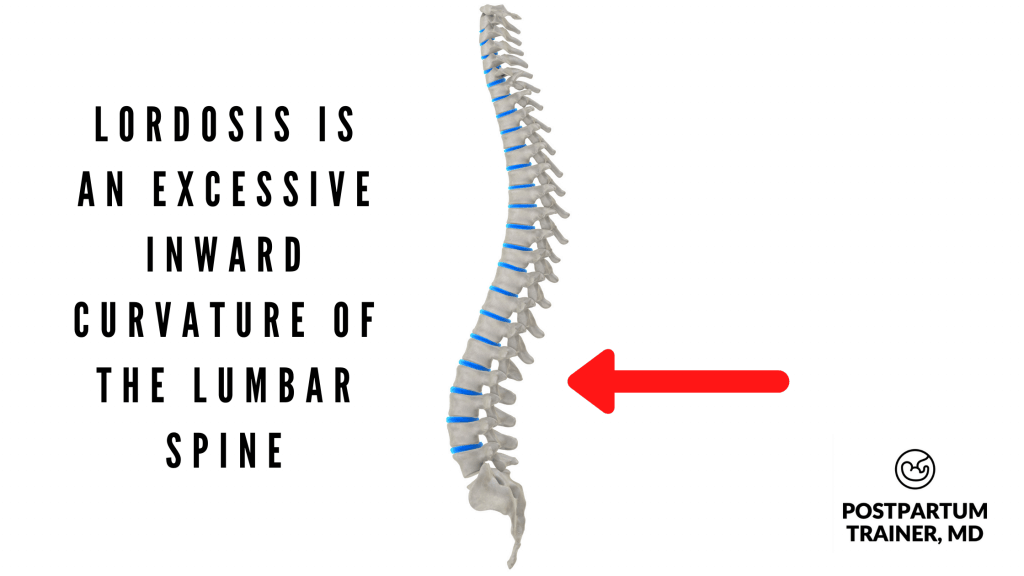
Is lordosis caused by pregnancy?
Pregnancy is definitely a risk factor for developing lordosis and other postural changes.
As your uterus grows bigger, your body experiences a shift in its center of gravity. This puts a lot of strain on the muscles of the low back as they have to compensate for the extra weight.
In addition, the growing uterus causes your abdominal muscles to stretch and weaken. This further worsens the issue as the ab muscles help keep the pelvis in a neutral alignment.
Ultimately, the imbalance between the abs and the low back tilt the pelvis forward creating lordosis.
When does lordosis occur in pregnancy?
Lordosis can occur during the late second and early third trimester of pregnancy.
This is when your fetus is growing the quickest and your uterus enlarges rather quickly.
The bigger the pregnancy gets, the more center of gravity shift you will experience.
What are the symptoms of lordosis?
Your spine is what helps connect every major joint in your body. Imbalances in one area of the spine can have many upstream and downstream consequences at other joints.
The symptoms of pregnancy lordosis include but are not limited to:
- low back pain
- hip pain
- inability to extend the hips completely, and
- knee pain
Unfortunately, over 60% of women suffer from pregnancy-related back pain.
This can be due to lordosis, pain at the sacroiliac joints, or even pubic symphysis separation.
Since these issues are mechanical in nature, the pain may be worse with physical activity and better with rest.
But, the good news is:
There are some non-invasive treatment options you can do to help alleviate your back pain!
How is lordosis treated during pregnancy – can it be fixed?
There are four things you need to do to reverse or alleviate pregnancy lordosis.
- stretching your hip flexors,
- strengthening your core,
- strengthening your glutes, and
- focusing on your posture
The anterior pelvic tilt of lordosis will place the hip flexors in a short and tightened position. That is why stretching your hip flexors is one of the most important things you have to do.
If you have tight hips, your pelvis won’t be able to restore a natural position and you won’t be able to fully activate your glute muscles either.
Secondly, you must strengthen your core muscles since they are stretched and weakened from the pregnancy.
This will help realign your pelvis and alleviate some of the mechanical stress on your low back.
Lastly, the anterior tilt will stretch and weaken your glute muscles. Strengthening your glutes will further alleviate your lumbar curvature and provide low back support.
Now let’s go over how to do each of these!
*Note: Before doing anything in this guide, speak to your doctor to make sure it is safe to do any of these exercises during pregnancy.*
If you are unsure of how to do these correctly, feel free to do them under the guidance of a physical therapist.
Hip Flexor Stretching
Kneeling hip flexor stretch
In this exercise, you will be kneeling on one knee, and stretching the hip of the knee that is on the floor.
To activate the stretch, make sure to lean forward and squeeze the glute of the bottom knee.
You can do it as a static hold, or you can rock back and forth.
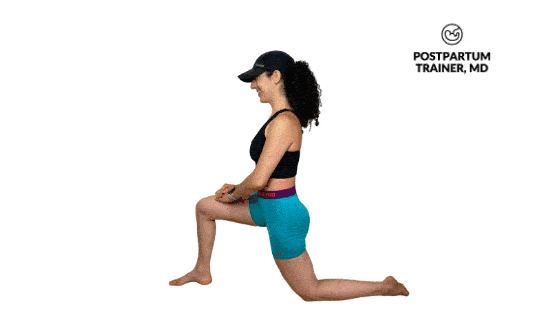
Standing hip flexor stretch
The standing hip flexor stretch is another way to do this exercise.
Just place one foot on an elevated surface to stretch the bottom leg’s hip.
Again, lean forward and squeeze the glute of the bottom leg.
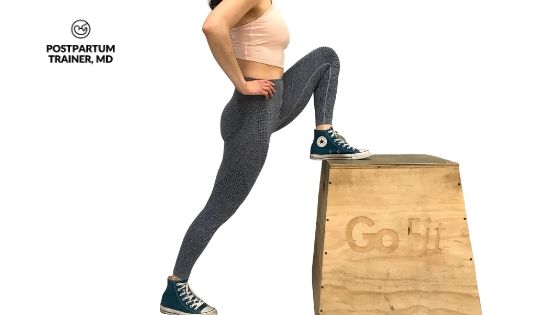
Core Strengthening Exercises
Standing posterior pelvic tilt
The posterior pelvic tilt is the easiest way to learn how to put your pelvis back into its natural alignment.
During pregnancy it is best you perform this exercise standing against a wall.
The idea is to flatten your back against the wall by engaging your abs and glute muscles.
Hold this position for a few seconds and repeat.
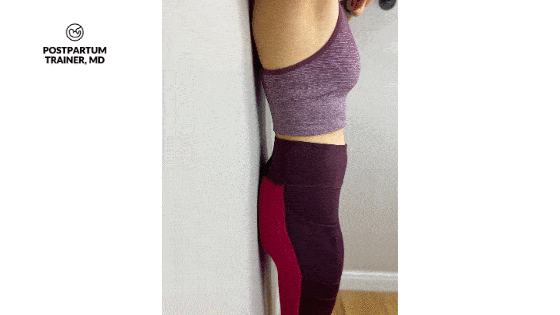
Bird Dogs
The bird dog is a safe way to strengthen your abs and glutes throughout your pregnancy as you will be on your hands and knees.
The idea is that you want to extend one leg behind you and raise the opposite arm out in front of you.
Really engage your core and squeeze your glute muscle of the top leg as you go through the movement.
Take your time and go through the movement slowly.
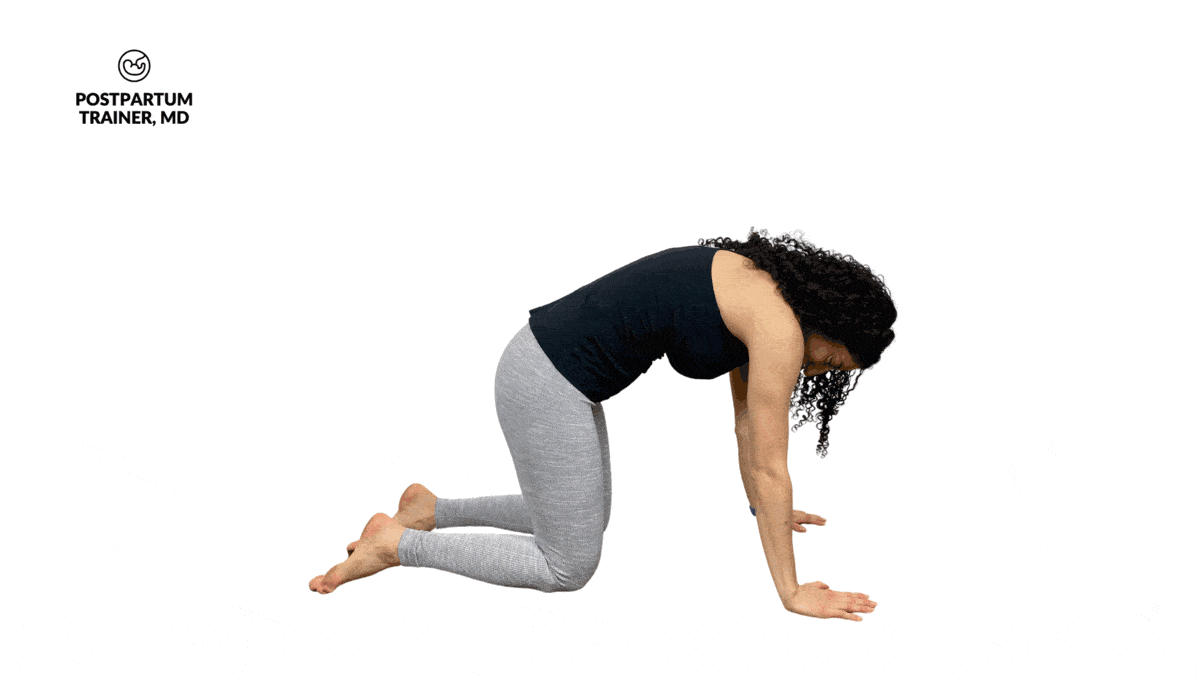
Scared Cat
The scared cat helps improve the mobility of your spine while also activating your deep core muscles.
From a quadruped position, try to round your back as much as you comfortably can.
Hold the position for a few seconds while contracting your abs.
Release and repeat.
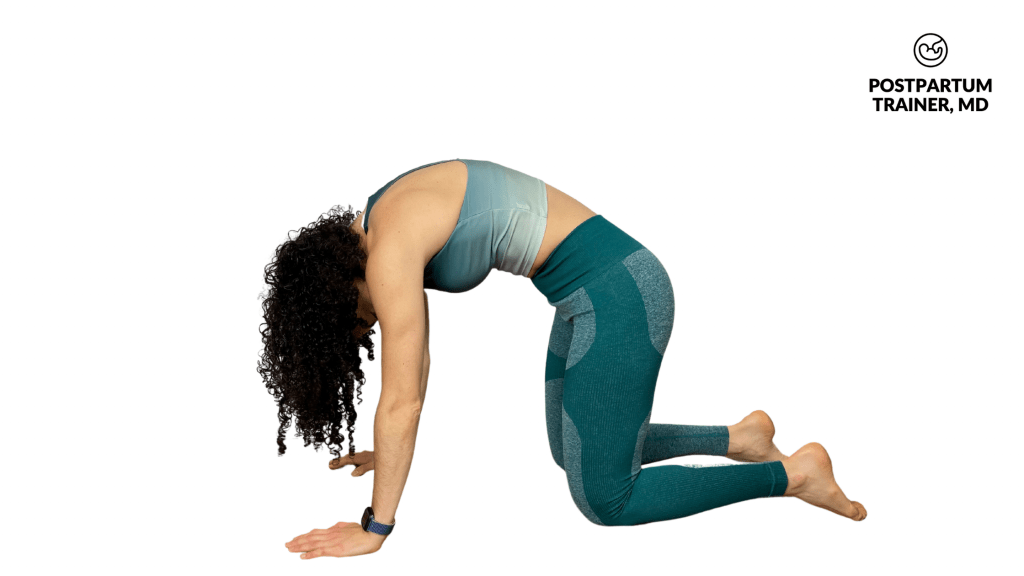
Bear to Cow
The bear to cow is another great way to strengthen your abs from a safe position.
The idea is that you want to transition from a quadruped position on your knees to a quadruped position on your tippy-toes, as if you were a bear. At the top position, make sure to really engage your core.
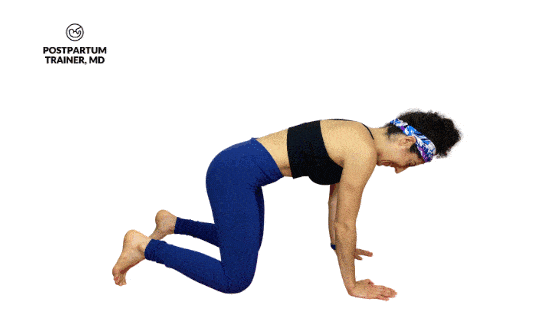
Glute Strengthening Exercises
Hip Thrust
The hip thrust is a great exercise to strengthen your glutes and entire posterior chain during pregnancy.
You will need to lean your back against something sturdy like a couch or a bench with your knees bent and feet flat on the floor.
From here really squeeze the glutes to extend the hips.
Hold it for a few seconds before repeating.
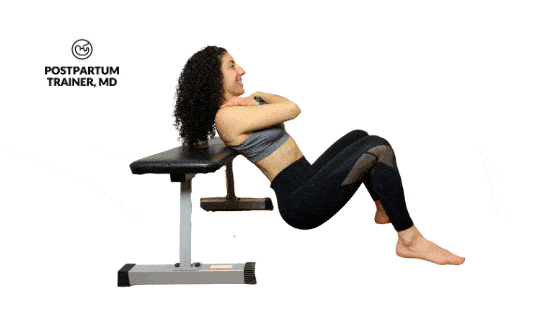
Reverse Lunge
The reverse lunge is another way you can train the entire posterior chain to help get rid of your lordosis.
Take a big step back as you are lunging down to activate the glutes more so than the thighs.
Be sure to hold onto the wall or chair to help with balance.
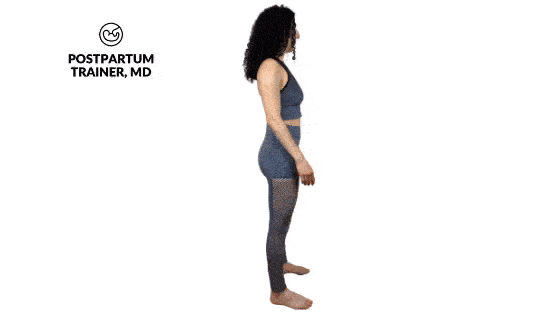
Band Quadruped Hip Extension
The band quadruped hip extension will require the use of a closed-loop resistance band to add additional resistance.
From a quadruped position, wrap the band around one foot and hold the other side in your hands in front of you.
From here, kick your leg straight back against the resistance of the band. Really engage your core and glute muscles.
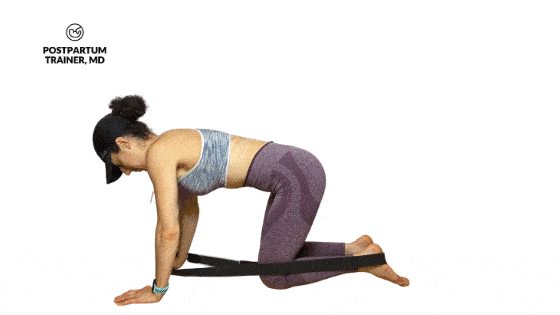
Dumbbell deadlift
The dumbbell deadlift is a full-body exercise that will train both your upper body and lower body at the same time.
The idea is to bend down by pushing your hips back and keeping a neutral posture of the spine.
As you stand up, squeeze your glutes hard.
If dumbbells are too heavy, you could try using a band.
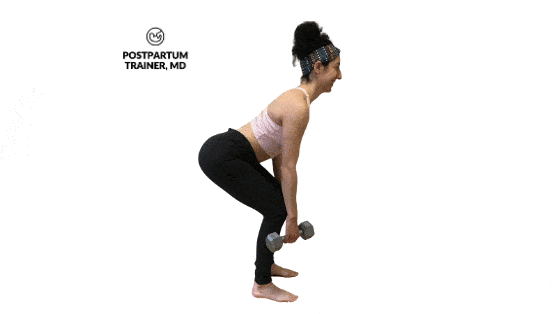
Postural Awareness
Lastly, you need to be aware of your posture throughout the day.
Bad posture is one of the reasons so many people suffer from chronic pain, especially in the neck and back.
As often as you can- try to keep your head is in a neutral position- in line with your shoulder, with your shoulders rolled back in their sockets (and not rounded forward), and your pelvis posteriorly tilted.
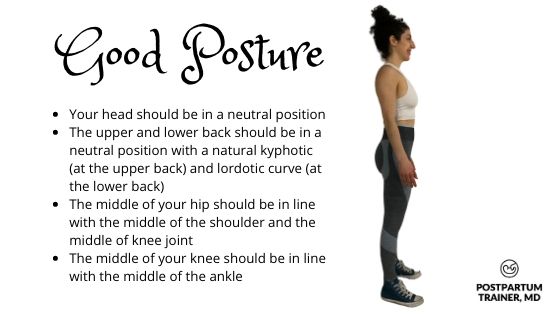
You can also use the exercises above to create a daily routine for yourself!
To learn more about fixing your posture, I have created a comprehensive at-home workout program called the Postpartum Trainer’s Posture Correction Guide that is on sale for just $7. It goes over 18 different exercises you can do to improve your posture, get rid of your lordosis, and improve your mobility. PLUS there is a 6-week workout template you can use in the comfort of your home!
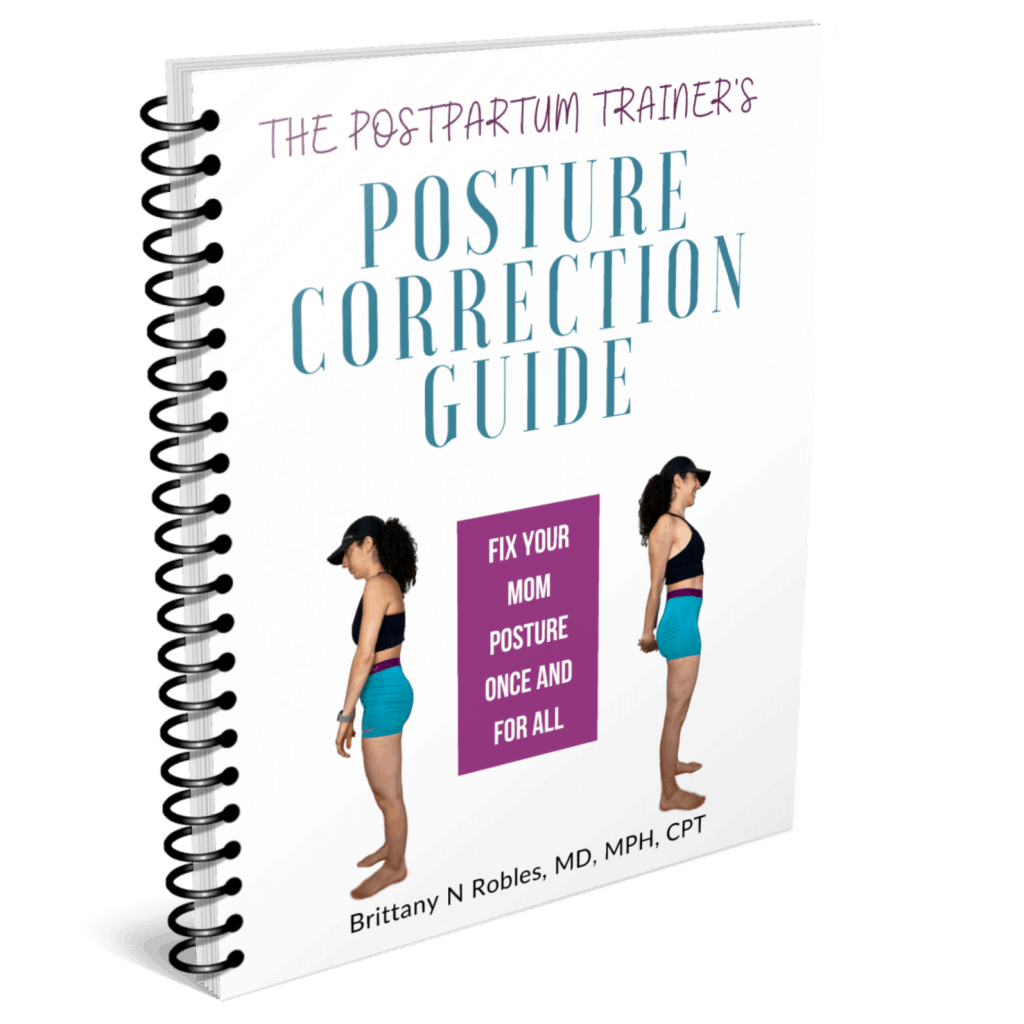
Can Lordosis be Prevented?
There is a possibility that lordosis can be prevented.
If you are able to maintain a strong core and strong glutes throughout pregnancy it is possible you can prevent this postural misalignment.
You should also do your best to keep your pregnancy weight gain to the recommended limits.
Lastly, do your best to maintain proper posture as often as you can. It is normal to slip into bad positions during your daily activities, but try your best to get out of them as often as you can.
Other Related Questions
When should I worry about back pain in pregnancy?
You should worry about back pain in pregnancy if you experience any of the following:
- severe low back pain that does not let you do your normal activities
- severe pain that radiates down the back of your leg (sciatic nerve irritation)
- incontinence of urine or feces
- chronic back pain that continues to get worse
If you experience any of these symptoms you should speak to a medical provider right away.
Can I have lordosis after pregnancy?
Yes, you can have lordosis in the postpartum period, especially if you had it throughout the gestation.
You must try to minimize any position that causes your low back to arch excessively while continuing to strengthen your core and glutes.
I go over the best posture exercises for postpartum women in this post.
What about kyphosis in pregnancy?
The additional weight of pregnancy can also lead to kyphosis, an excessive rounding of the thoracic spine.
This spinal change can lead to rounding of the shoulders and upper back problems.
Similar to lordosis, you must be aware of your standing position and sitting position as often as you can.
Do your best to avoid slouching and focus on strengthening your upper back muscles- but that’s a topic for another post!
Final Words on Lordosis in Pregnancy
So there you have the information you need to get rid of the lumbar lordosis causing your back pain.
Do you suffer from poor posture and lordosis?
What did you try to do to fix it?
Comment below and let me know.
Related Posts:
- How To Alleviate Pregnancy Related Pelvic Pain ( in The Sacroiliac Joint)
- Neck Pain In prgenancy [5 Things You Can Do For It]
- Wrist Pain In Pregnancy [Everything You Need To Know]
Get Four Free Workouts To Help Strengthen Your Pelvic Floor & Heal Your Mommy Tummy!

Brittany Robles, MD, MPH, CPT
Brittany Robles is a full-time OBGYN physician, a NASM certified trainer, and a prenatal and postnatal fitness specialist. She holds a Master of Public Health degree in maternal health with a special interest in exercise and nutrition. She is also the co-author of The White Coat Trainer. Learn more about her here.
Sharing is Caring – Send This To A Mom In Need!
References:
- Gutke A, Ostgaard HC, Oberg B. Association between muscle function and low back pain in relation to pregnancy. J Rehabil Med. 2008 Apr;40(4):304-11. doi: 10.2340/16501977-0170. PMID: 18382827.
- Wang SM, Dezinno P, Maranets I, Berman MR, Caldwell-Andrews AA, Kain ZN. Low back pain during pregnancy: prevalence, risk factors, and outcomes. Obstet Gynecol. 2004 Jul;104(1):65-70. doi: 10.1097/01.AOG.0000129403.54061.0e. PMID: 15229002.
- Shiri R, Coggon D, Falah-Hassani K. Exercise for the prevention of low back and pelvic girdle pain in pregnancy: A meta-analysis of randomized controlled trials. Eur J Pain. 2018 Jan;22(1):19-27. doi: 10.1002/ejp.1096. Epub 2017 Sep 4. PMID: 28869318.
